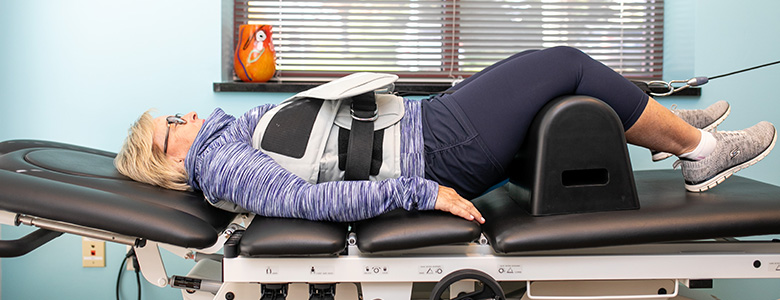Did you know prolonged sitting can have a profoundly negative effect on your body?
If you’re stuck at a desk all day and spend lots of time sitting when you’re not at work, you’re a prime candidate for several health issues. These include neck pain, low back pain, limited mobility, and poor posture.
Excessive sitting is also associated with an increased risk of several serious health concerns, including high blood pressure, heart disease, and stroke.
At Bomberg Chiropractic, we aim to provide holistic treatment that supports whole-body well-being, whether dealing with an acute issue or chronic pain or simply wanting to maintain good long-term health. If you feel your sedentary job has taken a toll on your health or worry that it might, we’re here to help.
If your daily life involves considerable time spent sitting, read about the health risks of a sedentary lifestyle and the measures you can take to keep yourself as healthy as possible.
Health Risks Associated With Excessive Sitting
Sitting all day at work might not seem like a potentially risky activity, but it can be more dangerous for your health than you might realize. And that’s especially true if you tend to flop on the couch after a long day’s work rather than lacing up your sneakers and hitting the road for a walk.
According to researchers, people who sit for more than eight hours daily and don’t engage in physical activity are at a similar risk of dying as those who smoke and are obese. And even people who exercise daily have a higher all-cause mortality risk when they spend several consecutive hours sitting each day.
Some of the many health risks associated with too much sitting include:
- Muscle atrophy and weakness occur when your muscle fibers shrink in size due to inactivity.
- Shortened hip flexors decrease the range of motion in the hip joints, leading to back pain.
- Tight hamstrings can negatively affect gait and balance and contribute to low back pain and knee stiffness.
- Progressive abdominal weakness leads to hunching, suboptimal posture, back strain, and discomfort (long-term, this can also contribute to herniated spinal discs).
- Muscle imbalances can result from atrophy and reduced flexibility caused by prolonged inactivity.
- Deep vein thrombosis (DVT) occurs when blood clots form in veins deep within the body and can result in pulmonary embolus, which can be fatal (DVT typically affects the lower extremities but may occur elsewhere)
- Elevated blood pressure can develop due to prolonged periods of inactivity.
What Happens When You Stand All Day?
When you have a hands-on job or a job involving frequent standing, such as teaching, paying attention to your body is important. Standing too long can put immense pressure on your lower limbs and lower back.
Standing relatively still for long stretches has been proven to reduce blood flow and is a major contributor to cardiovascular disease over years of the same activities.

Reduce Back Pain From Standing or Sitting for Long Stretches
Luckily, reducing your risk of developing health issues associated with prolonged sitting or standing isn’t tough at all!
Let’s look at some simple things you can do to stay as healthy as possible and ease back pain, even when you have a job that requires you to sit or stand for several hours each day.
Get Up & Move!
Taking periodic breaks from sitting is one of the easiest and most effective things you can do to dramatically reduce your risk of sitting-related health issues. So, while at work, ensure you get up and move throughout the day!
Research suggests that taking a brief break from your desk chair every 30 minutes or so to get up and move around can make a big difference in your health. If you know you’ll struggle to remember, set a timer to remind yourself.
And the best part is, you don’t have to do anything remotely strenuous. Just a few minutes of light movement will improve blood flow, keep your muscles more limber, and help prevent excessive tension and discomfort.

You can:
- Take a walk to the water fountain or break room
- Take a quick stroll down the stairs
- Do a couple of minutes of standing calf raises at your desk
- Stand while performing a few minutes of light stretching at your desk
- Take a short stroll on your lunch break
- Do a couple of minutes of air squats and/or lunges at your desk
- Take a mini dance break (maybe rally your colleagues to join in?)
- Re-situate yourself every 15-20 minutes. Shifting positions every once in a while can go a long way in making sure you’re comfortable throughout the day.
After moving around for a bit, ensure that when you sit back down, you do so with good posture. If you have questions about how to sit properly at work, feel free to ask! We’re always more than happy to help you learn healthier sitting habits.
Chiropractic Care: Essential Treatment for Desk Workers
If you must sit all day, one of the most effective things you can do to maintain your physical health is to schedule regular chiropractic treatments.
Comprehensive chiropractic care doesn’t just involve a quick adjustment once or twice weekly; it approaches whole-body health holistically. More importantly, it aims to help you maintain optimal function and well-being naturally in the long term.
With chiropractic wellness treatments, your chiropractor ensures your musculoskeletal system is properly aligned, mobile, and functioning appropriately. Even if you don’t necessarily feel pain, that doesn’t mean your musculoskeletal system doesn’t need attention.
Routine appointments allow your chiropractor to detect slight issues before they become glaringly painful so you continue to feel and function your best.
At Bomberg Chiropractic, we offer a variety of non-invasive therapies designed to address the physical problems associated with sedentary professions.
Chiropractic Adjustments
Low back pain, neck pain, tingling extremities, and headaches are common among desk workers. These issues often develop due to poor sitting posture, gradually shifting the spine from its normal alignment.
Routine chiropractic adjustments gently bring your musculoskeletal system back into proper alignment, which helps alleviate discomfort and stiffness while improving mobility and overall functioning.
Movement Based Massage
Prolonged sitting places your body in an unnatural position, reducing normal blood circulation and placing undue pressure on your spine and surrounding muscles. Muscle strain and poor circulation can lead to scar tissue development and painful muscular knots known as trigger points.
Connective tissues can also take a beating from excessive sitting, resulting in issues such as tendonitis and tendinosis. Eventually, muscular or connective tissue tension can contribute to nerve compression, compromising mobility, strength, and overall comfort.
Movement based massage is highly effective at gently correcting these musculoskeletal abnormalities while reducing discomfort and improving mobility.

TENS Therapy
Transcutaneous electrical nerve stimulation uses a low-voltage electrical current to stimulate nerve fibers and override pain signaling gently. If you suffer from chronic pain, tension, or muscle spasms, TENS therapy effectively alleviates discomfort and improves mobility.
Keep in mind, though, that while some patients experience long-term relief, the treatment typically elicits temporary results. TENS sessions are often combined with other chiropractic services for optimal results.
If you’re new to chiropractic treatment, check out 10 Common Questions About Seeing a Chiropractor to learn what you can expect.
Intersegmental Traction Therapy
With 4 in 10 office workers experiencing back pain, intersegmental traction therapy is a great option for anyone looking for a non-evasive option that removes the need to use prescription pain medication. The therapy involves a treatment table designed to manipulate the vertebrae, which starts from the bottom of your spine and goes to your neck, which stretches your spine, removing pressure on the discs.
Intersegmental traction therapy removes the pressure on the lower back and spine and can decrease back pain by maintaining spine alignment for proper ergonomic positioning.
Spinal Decompression Therapy
Sitting and standing all day puts extra pressure on the spine, leading to compressed nerves and increased chances of injury, aging, and inflammation.
Spinal decompression therapy uses a harness fitted around your pelvis and another around the trunk of your body as you lie on a specialized table. The doctor controls the movement via a pulley system that stretches the affected areas experiencing pain.
Spinal decompression therapy is another excellent non-surgical option for those who have desk jobs and experience issues like sciatica, back or neck pain, and bulging discs and is considered an effective treatment option.

Set Your Desk Up for Success
How you sit can be more detrimental than the sitting itself! Set up your work area to facilitate proper posture and ease of use, so you’re not placing excess stress on your body.
Here are a few simple things you can try:
- Use a standing desk, if possible
- Keep your computer at eye level to ensure a healthy neck posture
- Use an ergonomic chair designed to support back health
- Adjust your chair so that your arms and shoulders are relaxed while typing
- Keep both feet flat on the floor — no crossing your legs!
- Upgrade your accessories for better ergonomic positioning
- Don’t slouch! Sit up straight and tall, keep your hips close to the back of the chair, try not to lean toward either side and make sure your thighs form a 90° angle with your torso.
It’s also helpful to shift your position slightly about every 30 minutes or so. Adding in a bit of gentle stretching can also keep discomfort and slouching at bay.

Schedule Chiropractic Care in New Hope, MN
When you’re forced to sit all day for work, it can be easy to forget what it feels like to have a healthy, high-functioning body. At Bomberg Chiropractic, our goal is to help you remember!
If you’ve been struggling with chronic back pain or neck pain, headaches, tingling extremities, or other physical issues associated with excessive sitting, our team is here to help. To learn more about our wide variety of chiropractic services or to schedule an appointment, give our office a call at 763-450-1755.
You can also contact us online with any questions or concerns, and a member of our team will reach out to you promptly!